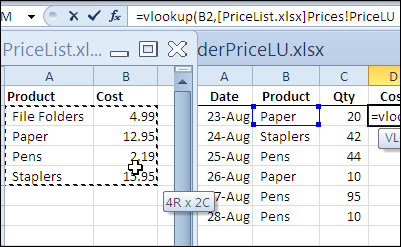
/vlookup-excel-examples-19fed9b244494950bae33e044a30370b.png)
The word "range" in this case refers to "range of values" – when range_lookup is TRUE, VLOOKUP will match a range of values rather than an exact value. VLOOKUP has two modes of matching, exact and approximate, controlled by the fourth argument, range_lookup. To lookup values to the left, see INDEX and MATCH, or XLOOKUP. VLOOKUP can only look to the right. In other words, you can only retrieve data to the right of the column that holds lookup values: Above, the references are relative to make them easier to read. Note: normally, we would use an absolute reference for H3 ($H$3) and B4:E13 ($B$4:$E$13) to prevent these from changing when the formula is copied.

= VLOOKUP (H3 ,B4:E13, 2, FALSE ) // first name = VLOOKUP (H3 ,B4:E13, 3, FALSE ) // last name = VLOOKUP (H3 ,B4:E13, 4, FALSE ) // email address For example, to get the name for order 1004, the formula is: ID, Amount, Name, and State for any order. With the Order number in column B as the lookup_value, VLOOKUP can get the Cust. The purpose of VLOOKUP is to look up information in a table like this: See below for more information on matching. Important: range_lookup is optional and defaults to TRUE, so VLOOKUP will perform an approximate match by default. If range_lookup is FALSE, VLOOKUP will perform an exact match. If range_lookup is TRUE, VLOOKUP will perform an approximate match. Finally, range_lookup controls match behavior. The column_index_num argument is the column number of the value to retrieve, where the first column of table_array is column 1.

The first column of table_array must contain the lookup values to search. Lookup_value is the value to look for, and table_array is the range of vertical data to look inside. VLOOKUP takes four arguments: lookup_value, table_array, column_index_num, and range_lookup. The key to using VLOOKUP successfully is mastering the basics. In addition, VLOOKUP's default matching behavior makes it easy to get incorrect results. This makes it hard to use VLOOKUP with multiple criteria. Unlike INDEX and MATCH (or XLOOKUP), VLOOKUP needs a complete table with lookup values in the first column. On the bad side, VLOOKUP is limited and has dangerous defaults. Using VLOOKUP successfully is a rite of passage: from beginner to skilled Excel user. For new users in particular, it is immensely satisfying to watch VLOOKUP scan a table, find a match, and return a correct result. On the good side, VLOOKUP is easy to use and does something very useful. VLOOKUP is probably the most famous function in Excel, for reasons both good and bad. Vertical data | Column Numbers | Only looks right | Matching Modes | Exact Match | Approximate Match | First Match | Wildcard Match | Two-way Lookup | Multiple Criteria | #N/A Errors | Videos Introduction VLOOKUP supports approximate and exact matching, and wildcards (* ?) for partial matches. Lookup values must appear in the first column of the table passed into VLOOKUP. VLOOKUP is an Excel function to get data from a table organized vertically.


 0 kommentar(er)
0 kommentar(er)
